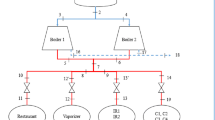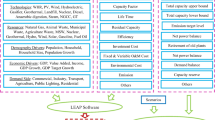Abstract
Small-scale distributed power generation offers environmental benefits through the improvement of global energy efficiency, in addition to increasing the reliability of the power supply. In this study, the technical and economic viability of the implementation of micro-cogeneration technology in the manufacturing sector was studied in light of the Brazilian regulatory situation. The thermal efficiency potential for the manufacturing sector is introduced for further exploration by decision-makers. This study also investigated the behavior of micro-cogeneration in distributed generation through the Brazilian Energy Compensation System. The technical viability was studied by simulating a Brayton cycle with the operation parameters of a 100 kW micro-turbine. This simulation allowed an estimation of the avoided cost of natural gas compared to an industrial process without cogeneration. Rate projections were performed by linear regression during the system’s depreciation period. The economic evaluation was performed using the following indicators: net present value (NPV), internal rate of return (IRR), and discounted payback. Finally, a sensitivity study was performed to project how the micro-cogeneration efficiency and the Brazilian regulations can address future variations of natural gas and electricity rates. Given the conditions of this study, the increase in energy prices favors micro-cogeneration; however, the economic viability is affected if the system operates below 70% of heat use in industrial processes, which reduces the effect of public policies toward the incentive to cogenerate.










Similar content being viewed by others
Notes
ANEEL – Agência Nacional de Energia Elétrica (National Electricity Agency).
Agência reguladora de Saneamento e Energia do Estado de São Paulo (State of Sao Paulo Sanitation and Energy Regulatory Agency).
References
ANEEL. (2015). Agência Nacional de Energia Elétrica. Acesso em 10 de 10 de 2015, disponível em http://www.aneel.gov.br/cedoc/ren2012482.pdf
ARSESP. (2015). Agencia Reguladora de Saneamento e Energia do Estado de São Paulo. Acesso em 10 de 10 de 2015, disponível em http://www.arsesp.sp.gov.br/
Aussant, D., Fung, A., Ugursal, V., & Taherian, H. (2009). Residential application of internal combustion engine based cogeneration in cold climate—Canada. Energy and Buildings, 41, 1288–1298.
Badami, M., Casetti, A., Campanile, F., & Anzioso, F. (2007). Performance of an innovative 120 kWe natural gas cogeneration system. Energy, 32, 823–883.
Bajay, S. V., Gorla, F., & Bordoni, O. (2009). Os segmentos industriais energo-intensivos de maiores potenciais técnicos de conservação de energia no Brasil. Revista Brasileira de Energia, 15(Nº1), 89–107.
BCB. (2015). Banco Central do Brasil. Acesso em 14 de 12 de 2015, disponível em Banco Central do Brasil: www.bcb.gov.br
Bidini, G., Desideri, U., Saetta, S., & Bocchini, P. (1998). Internal combustion engine combined heat and power plants: case study of the University of Perugia power plant. Applied Thermal Engineering, 18, 401–412.
Bruckner, T., Morrison, R., & Wittmann, T. (2005). Public policy modeling of distributed technologies: strategies, attributes and challenges. Ecological Economics, 54, 328–345.
Canova, A., Chicco, G., Genon, G., & Mancarella, P. (2008). Emission characterization and evaluation of natural gas-fueled cogeneration microturbines and internal combustion engines. Energy Conversion and Management, 49, 2900–2909.
Celador, A. C., Erkoreka, A., Escudero, K. M., & Sala, J. (2011). Feasibility of small-scale gas engine-based residential cogeneration in Spain. Energy Policy, 39, 3813–3821.
COMGÁS. (2014). Companhia de Gás de São Paulo. Acesso em 12 de 05 de 2014, disponível em http://www.comgas.com.br/pt/comgasParaVoce/Industrial/Paginas/Cogeracao.aspx
Ehyaei, M., & Mozafari, A. (2010). Energy, economic and environmental (3E) analysis of a micro gas turbine employed for on-site combined heat and power production. Energy and Buildings, 42, 259–264.
EPA. (2015). Acesso em 12 de 12 de 2015, disponível em http://www3.epa.gov/chp/documents/catalog_chptech_5.pdf
Faber, A., Valente, M., & Jansen, P. (2006). Exploring domestic micro-cogeneration in the Netherlands: an agent-based demand model for technology diffusion. Energy Policy, 38, 2763–2775.
Ferrari, M., Pascenti, M., & Bertone, R. (2009). Hybrid simulation facility based on commercial 100kWe micro gas turbine. ASME. Journal of Fuel Cell Science and Technology, 6(3) 031008-031008-8.
Fragaki, A., Andersen, A., & Toke, D. (2008). Exploration of economical sizing of gas engine and thermal store for combined heat and power plants in the UK. Energy, 33, 1659–1670.
Ganapathy, V. (1991). Waste heat boiler deskbook. Atlanta: Fairmon, Press.
Hinojosa, L., Day, A., Maidment, G., & Dunham, C. K. (2007). A comparisonof combined heat and power feasibility models. Applied Thermal Engineering, 27, 2166–2172.
Katsigiannis, P., & Papadopoulos, D. (2005). A general technoeconomic and enviromental procedure for assessment of small-scale cogeneration scheme instalations: application to a local industry operating in Thrace, Greece, using microturbines. Energy Conversion and Management, pp., 3150–3174.
Khan, K., Rasul, M., & Khan, M. (2004). Energy conservation in buildings: cogeneration and cogeneration coupled with thermal energy storage. Applied Energy, 77, 15–34.
Kostowski, W., & Skorek, J. (2005). Thermodynamic and economic analysis of heat storage application in co-generation systems. International Journal of Energy Research, 29, 177–188.
Medrano, M., Brouwer, J., McDonell, V., Mauzey, J., & Samuelsen, S. (2008). Integration of distributed generation system into generic types of commercial buildings in California. Energy and Buildings, 40, 537–548.
MME. (2015). Ministério de Minas e Energia. Acesso em 15 de 10 de 2015, disponível em http://www.mme.gov.br/web/guest/publicacoes-e-indicadores/plano-nacional-de-eficiencia-energetica
Moreira, N. A., Monteiro, E., & Ferreira, S. (2007). Transposition of the EU cogeneration directive: a vision for Portugal. Energy Policy, 35, 5747–5753.
Pilavachi, P. (2002). Mini- and micro-gas turbines for combined heat and power. Applied Thermal Engineering, 22, 2003–2014.
Rosen, M. A. (2009). Energy, environmental, health and cost benefits of cogeneration from fossil fuels and nuclear energy using the electrical utility facilities of a province. Energy for a Sustainable Development, 13, 43–51.
Sant’Ana, P. (2009). Desenvolvimento da competição e da infra estrutura na indústria de gás natural no Brasil - TESE. Campinas - SP: UNICAMP.
Silveira, J., Walter, S., & Luengo, C. A. (1997). A case study of compact cogeneration using various fuels. Fuel, 76, 447–451.
Streckienè, G., Martinaitis, V., Andersen, A., & Katz, J. (2009). Feasibility of CHP-plants with thermal stores in the German spot market. Applied Energy, 86, 2308–2316.
Thermoflow. (2014). GT PRO / GT MASTER. Acesso em 12 de 05 de 2014, disponível em Thermal Engineering Software for the Power Industry: www.thermoflow.com/combinedcycle_GTM.html
Thornton, A., & Monroy, C. (2011). Distributed power generation in the United States. Renew Sustain Energy Reviews, 15, 4809–4817.
Turbec T100. (2003). Instalation Handbook.
Vandewalle, J., & D’haeseleer, W. (2014). The impact of small scale cogeneration on the gás demand at distribuition. Energy Conversion and Management, 78, 137–150.
Walter, A., Llagostera, B., & Gallo, W. (1997). Analysis of thermodynamics performance parameters and cost allocation methods in cogeneration systems. Thermodinamics Analysis and Improvement of Energy Systems.
Watson, J., Saute, R., Bahaj, B., James, P., Myers, L., & Wing, R. (2008). Domestic micro-generation: economic, regulatory and policy issues for the UK. Energy Policy, 36, 3095–3106.
Wu, B., & Wang, L. (2014). Comparable analysis methodology of CCHP based on distributed energy system. Energy Conversion and Management, 88, 863–871.
Acknowledgements
This work was sponsored by the Brazilian Federal Agency for the Support and Evaluation of Graduate Education (Coordenação de Aperfeiçoamento de Pessoal de Nível Superior (CAPES)).
Author information
Authors and Affiliations
Corresponding author
Annex 1
Annex 1
Rates | Time series (year) | ||||||||||||||
2003 | 2004 | 2005 | 2006 | 2007 | 2008 | 2009 | 2010 | 2011 | 2012 | 2013 | 2014 | 2015 | |||
Electricity-Industrial [R$/kWh] | 0.1317 | 0.1574 | 0.1994 | 0.2213 | 0.2331 | 0.2204 | 0.2406 | 0.2422 | 0.2492 | 0.2588 | 0.2326 | 0.2582 | 0.3873 | ||
Natural Gas-Cogeneration-Class 2 [R$/m3] | 0.5702 | 0.5632 | 0.5974 | 0.6565 | 0.6346 | 0.7227 | 0.7300 | 0.7810 | 0.7978 | 1.0446 | 1.2015 | 1.2544 | 1.3821 | ||
Natural Gas-Industrial -Class 1 [R$/m3] | 0.9432 | 0.9857 | 1.0184 | 1.1267 | 1.1538 | 1.4500 | 1.3729 | 1.3269 | 1.3293 | 1.5888 | 1.7653 | 1.8268 | 2.0114 | ||
Rates | Projection (year) | ||||||||||||||
2016 | 2017 | 2018 | 2019 | 2020 | 2021 | 2022 | 2023 | 2024 | 2025 | 2026 | 2027 | 2028 | 2029 | 2030 | |
Electricity-Industrial [R$/kWh] | 0.3231 | 0.3360 | 0.3488 | 0.3617 | 0.3745 | 0.3874 | 0.4002 | 0.4131 | 0.4259 | 0.4387 | 0.4516 | 0.4644 | 0.4773 | 0.4901 | 0.5030 |
Natural Gas-Cogeneration-Class 2 [R$/m3] | 1.3140 | 1.3816 | 1.4491 | 1.5167 | 1.5842 | 1.6517 | 1.7193 | 1.7868 | 1.8544 | 1.9219 | 1.9895 | 2.0570 | 2.1245 | 2.1921 | 2.2596 |
Natural Gas-Industrial -Class 1 [R$/m3] | 1.9621 | 2.0457 | 2.1293 | 2.2129 | 2.2965 | 2.3801 | 2.4637 | 2.5474 | 2.6310 | 2.7146 | 2.7982 | 2.8818 | 2.9654 | 3.0490 | 3.1326 |
Rights and permissions
About this article
Cite this article
Landini, C.L., de Mello Sant’Ana, P.H. Technical, economic, and regulatory analysis of the implementation of micro-cogeneration technology in the Brazilian manufacturing sector. Energy Efficiency 10, 957–971 (2017). https://doi.org/10.1007/s12053-016-9496-x
Received:
Accepted:
Published:
Issue Date:
DOI: https://doi.org/10.1007/s12053-016-9496-x




